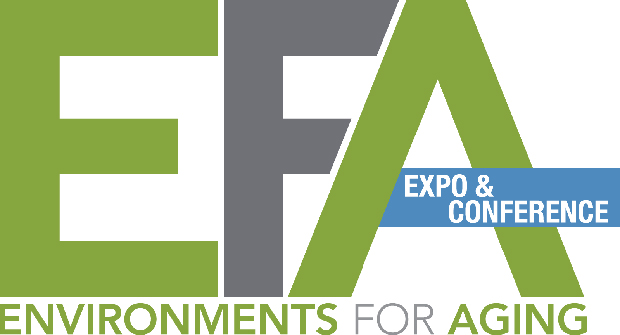Notes from the EFA Conference in Savannah, GA
July 2018

In April, Montag Architects attended our first Environments For Aging (EFA) conference in Savannah, Georgia. As stated by Debra Levin, President and CEO of The Center for Health Design, the goal of the EFA conference is "To bring together the myriad of stakeholders involved in creating a diverse collection on environments for seniors that promote healthy aging and maintain the dignity of their residents."
Our goal in attending the conference was to discover new trends in senior living and connect with and learn from this "myriad of stakeholders". We attended educational sessions on resident-centered regulatory improvements, post-occupancy evaluation reviews, the resident-centered approach to planning, design, and construction, environments for the generations, radical transformations - turning tired old buildings into "the place to be", and the IBC 2015 international Building Code and what it means for assisted living.
Top Three EFA Conference Takeaways
The Household Model Rules
I will never forget hearing my father say, "Don't you ever put me in a nursing home." When you think about that statement for a moment you begin to understand the fear and dread that many seniors feel at the prospect of having to move to such a place. You think about the long, sterile hallways very similar to a hospital, losing your independence, and the feeling of being isolated due to the lack of social interaction. The institutional approach with one large central dining room, repetition of corridors with room after room on both sides, and institutional finishes are being replaced with households which means smaller "neighborhoods" that create an atmosphere more like home. These households limit the number of residents in a group and generally accommodate between 10 – 18 people. Each has its own living room, dining room, and smaller kitchen that is accessible to residents just like at home in place of a huge commercial kitchen with no access. The household model gives residents a sense of ownership and control.
Though the household model is a more recent design development, we started implementing this model in 1997 at facilities like Heritage House in Atlantic, Iowa and Park Center in Newton, Iowa. Our goal was to give residents a better way to stretch their legs and interact with one another. Rather than taking a walk down a long corridor to stop, turn around and walk back, we created smaller neighborhoods so residents could walk in a circular pattern from one neighborhood or household to another.
The household model is not just about the physical structure of the building and creating smaller groups of people, it also includes a change in philosophy of care that empowers residents and ensures that seniors live with a sense of well-being. This means not being regimented by a strict schedule, rules, and boundaries, but giving resident more freedom to choose such things as wake up time, meal times and menus, showers, and activities.
In the household model there are also changes in how the staff interacts with residents. Certified nursing assistants are often referred to as partners who make sure the resident's needs and wishes are attended to. This facilitates the residents making choices and decisions for themselves. This shift in approach to caregiving helps to create meaningful relationships.
When I look at current trends, my guess is dad would have a different opinion of nursing homes were he alive today. Hopefully, due to this household model, feelings of dread at the prospect of having to move in are being replaced with a sense of optimism and excitement.
Assisted Living Can Be I-1 or I-2 Occupancy
This takeaway hits close to home as we recently completed conversion work for administrator, Shannon Minshall at Fleur Heights Care Center in Des Moines, Iowa. We provided a code review and a plan for the conversion of a Skilled I-2 (Institutional 2) occupancy space to an assisted living, dementia specific space.
Assisted living I-1 occupancy defined:
Condition 1: This occupancy condition shall include buildings in which all persons receiving custodial care who, without any assistance, are capable of responding to an emergency situation to complete building evacuation.
Condition 2: This occupancy condition shall include buildings housing any persons receiving custodial care who require limited verbal or physical assistance while responding to an emergency situation to complete building evacuation.
Assistance with evacuation can occur because of care recipient's physical or mental limitations or both. Assistance with evacuation would include assisting persons who may have resistance or confusion in response to an alarm.
Assisted living I-2 occupancy defined:
Institutional Group I-2 occupancy shall include buildings and structures used for medical care on a 24 hour basis for more than five persons who are incapable of self-preservation.
Advantages for classifying assisted living as I-2 include:
- I-2 is inherently safe
- I-2 provides more flexibility for common areas
- I-2 does not require door closers
- Memory care resident room doors can be left open
- Provides more flexibility for aging in place
- There is no prohibition from a code perspective on voluntarily upgrading assisted living use to a higher standard.
The Best is Not Yet to Come
The bottom line - housing options for the aged are the best they have ever been! Thankfully, that's true! There have never been more options available for seniors. From aging in place, to housing cooperatives, to the village concept, to independent living, continuing care retirement communities, to assisted living, to skilled nursing, the options are out there. The task then is look at your needs and budget to help narrow the housing option down to what works best for your situation.